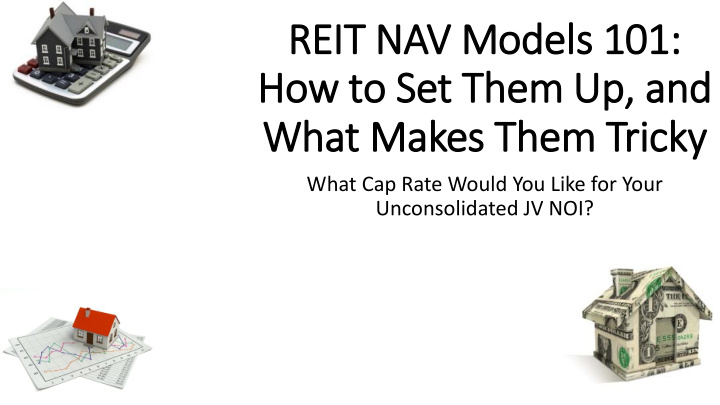



REIT NAV Models 101: How to S Set Them Up, and What Makes Them Tricky What Cap Rate Would You Like for Your Unconsolidated JV NOI?
Question That We Get A Lot… “I’ve looked at examples of Net Asset Value (NAV) Models online and in various articles, but they seem too easy. ” “You re - value the REIT’s Assets and Liabilities, and then subtract Liabilities from Assets. What’s so hard about it?”
The Short Answer • Yes, the basic idea behind a NAV Model for REITs is simple – just like anything else in accounting/finance • But… as with a DCF, there are some tricky parts, and it’s challenging to come up with reasonable assumptions in some cases • The NAV Model is mostly about judgment – how much is Item X worth? What about Item Y? • So, we’ll start with the basic idea using a simplified example and then show you two more-complex examples that illustrate why this analysis is more complicated than it seems at first glance
NAV Model: The Basic Idea • A REIT’s Properties are recorded at historical cost minus accumulated Depreciation • But unlike factories/equipment that wear down and need to be replaced, buildings and land rise in value over the long term • So, the book value of Property on the Balance Sheet dramatically understates its fair market value • Only U.S.-Based REITs: IFRS-based REITS do mark their properties to fair market value, so the NAV Model is far less useful – there might be minor adjustments, but nothing massive in most cases
NAV Model: The Basic Idea • First: Project the forward “Net Operating Income” (operating income from properties) and divide by an appropriate “Cap Rate” or “Yield” • Second: Value the other assets; small premium for Construction, set Goodwill/Intangibles to 0, and the rest should stay about the same • Third: Adjust the Liabilities – main adjustment is to take the fair market value of Debt if interest rates or credit risk have changed • Fourth: Subtract the adjusted Liabilities from the adjusted Assets to calculate Net Asset Value (NAV), and then NAV per Share
Why NAV Models Can Get More Complex • Complication #1: How do you project the forward NOI? Do you need to adjust it for Replacement Reserves or other items? • Complication #2: How do you handle the REIT’s Acquisition, Development, Redevelopment, and Disposition activity? • Complication #3: How do you pick the Cap Rate or range of Cap Rates to use? • Complication #4: How do you handle Joint Ventures and the fact that Debt associated with them does not appear directly on the Balance Sheet?
Why NAV Models Can Get More Complex • Forward NOI: Typically, you annualize the most recent quarter’s NOI, adjust for non-cash items, and assume a growth rate – or you could create segment-level projections and use them instead • Acquisitions, Developments, Dispositions: Detailed projections, or adjust the MRQ NOI, and reflect the cost in the Assets and Liabilities • Cap Rates: Use brokerage firms like Jones Lang LaSalle (JLL) and their industry data; you could Google much of this information • JV Assets/Liabilities: Must separate out the JV Assets and Liabilities, re-value them, and multiply by the ownership percentage(s)
The Avalo lonBay [AVB] NAV Model • Forward NOI: We built projections for the 6 established (same-store) segments and then forecast NOI from other activities; deducted Replacement Reserves • Acquisitions, Developments, Dispositions: We projected the NOI from these directly; excluded the assets from Construction in Progress! • Cap Rates: We used JLL data for Class-A properties in different geographies as of the time of this valuation • JV Assets/Liabilities: We created a “mini - projection” for the JVs, capped the NOI and multiplied by AVB’s ownership, and then adjusted the JV Assets, Debt, and Other Liabilities
The Dig igital l Realt lty [DLR] NAV Model • Forward NOI: Annualized the most recent quarter’s NOI, adjusted for non-cash items, dispositions, and new developments, and assumed a growth rate over the next 12 months • Acquisitions, Developments, Dispositions: Adjusted annualized NOI for these and reflected the costs on both the Assets and L&E sides • Cap Rates: Googled for Data Center Cap Rates; seemed to be in the 6.5% – 7.5% range nationwide; Northern VA and CA a bit lower • JV Assets/Liabilities: No separate projections in this case – we just took the company’s disclosures at face value and used the numbers in their quarterly report
What’s the “Best” Approach? • Question: How much time and energy can you devote to the analysis? How important is it? • Question 2: How much data do you have? Cap Rates by region? • Quick Analysis / Not Much Data → The Digital Realty approach is better because you don’t need detailed projections, regional Cap Rates, etc. • In-Depth Analysis / More Data → The AvalonBay approach is better because property values differ significantly by region, even within similar areas like “Coastal U.S.”
Recap and Summary • Part #1: The Basic Idea Behind a NAV Model (Park Hotels) • Part #2: Why NAV Models Can Get More Complex • Part #3: Two More-Complex NAV Examples for AvalonBay [AVB] and Digital Realty [DLR]
Recommend
More recommend